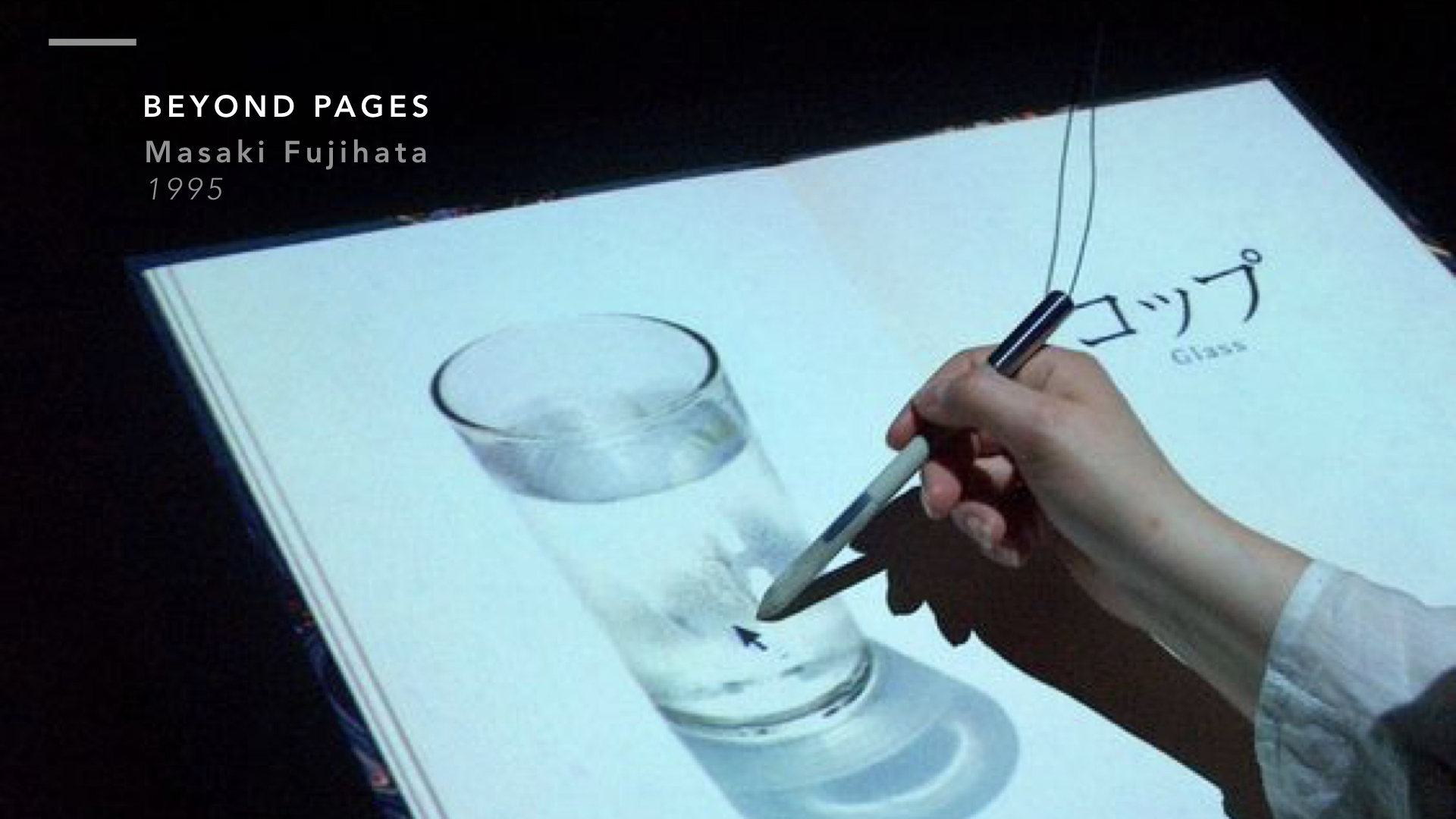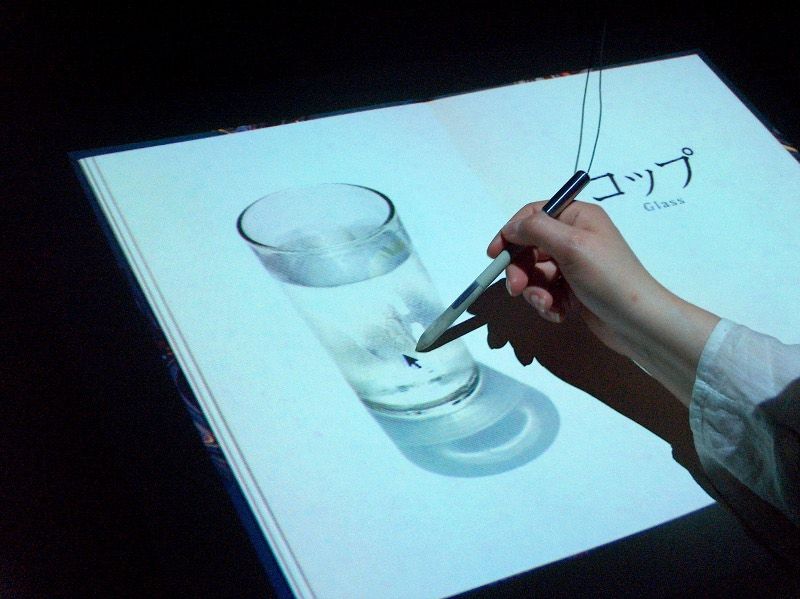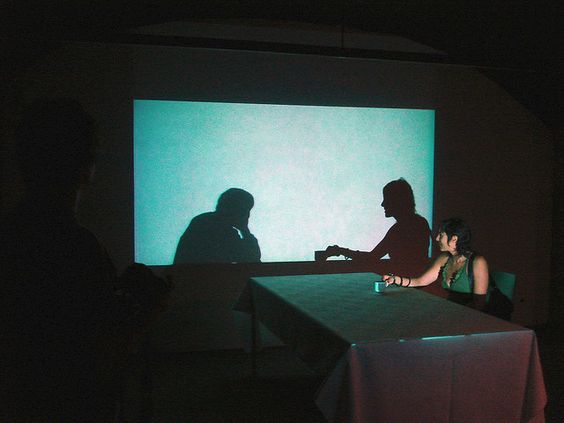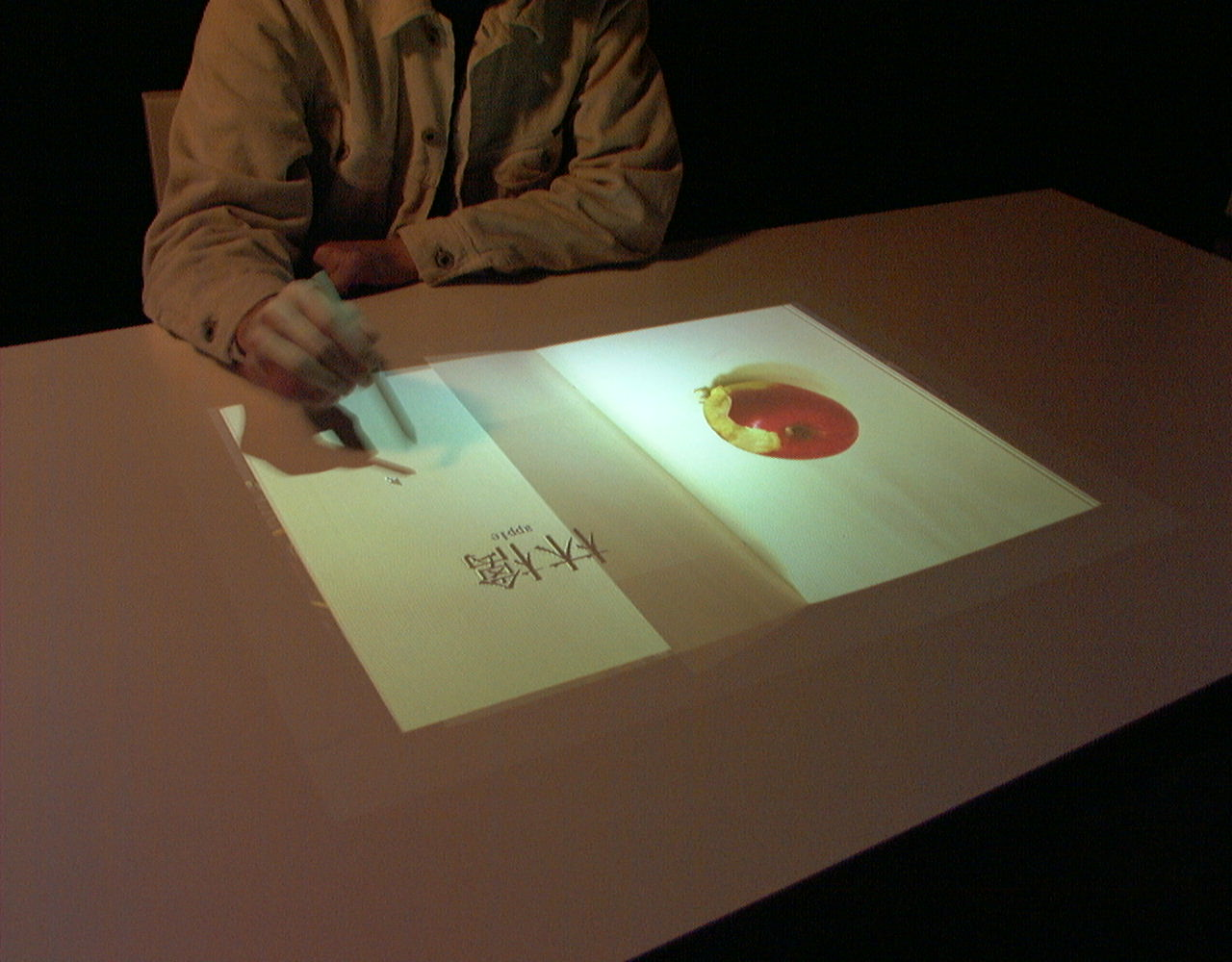
| beyond pages | masaki fujihata |
Introduction
Masaki Fujihata is one of the pioneers of Japanese New Media art. He graduated from the Faculty of Fine Arts from Tokyo University of the arts. As a new media art practitioner, Masaki Fujihata has exhibited in galleries and museums all around the world. His works are very well-received by people.
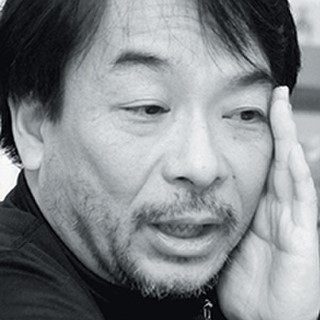
A computer-based installation created in 1995 by Masaki Fujihata, Beyond Pages, is an example of an artwork made to encourage interactivity and a form of audience feedback. Working within the sphere of cognition and imagination, Beyond Pages, turns a seemingly natural everyday scene/situation into an area of exploration and play.
As one enters the scene and sits on the chair, he/she will find a virtual picture book on the table in front of them. This picture book is the essence of the installation, each page showing one item each in images or letters. The items and images come to motion upon any form of interaction. For example, when an apple is touched, the responding action will be the apple getting bitten into, accompanied with respective biting sounds.
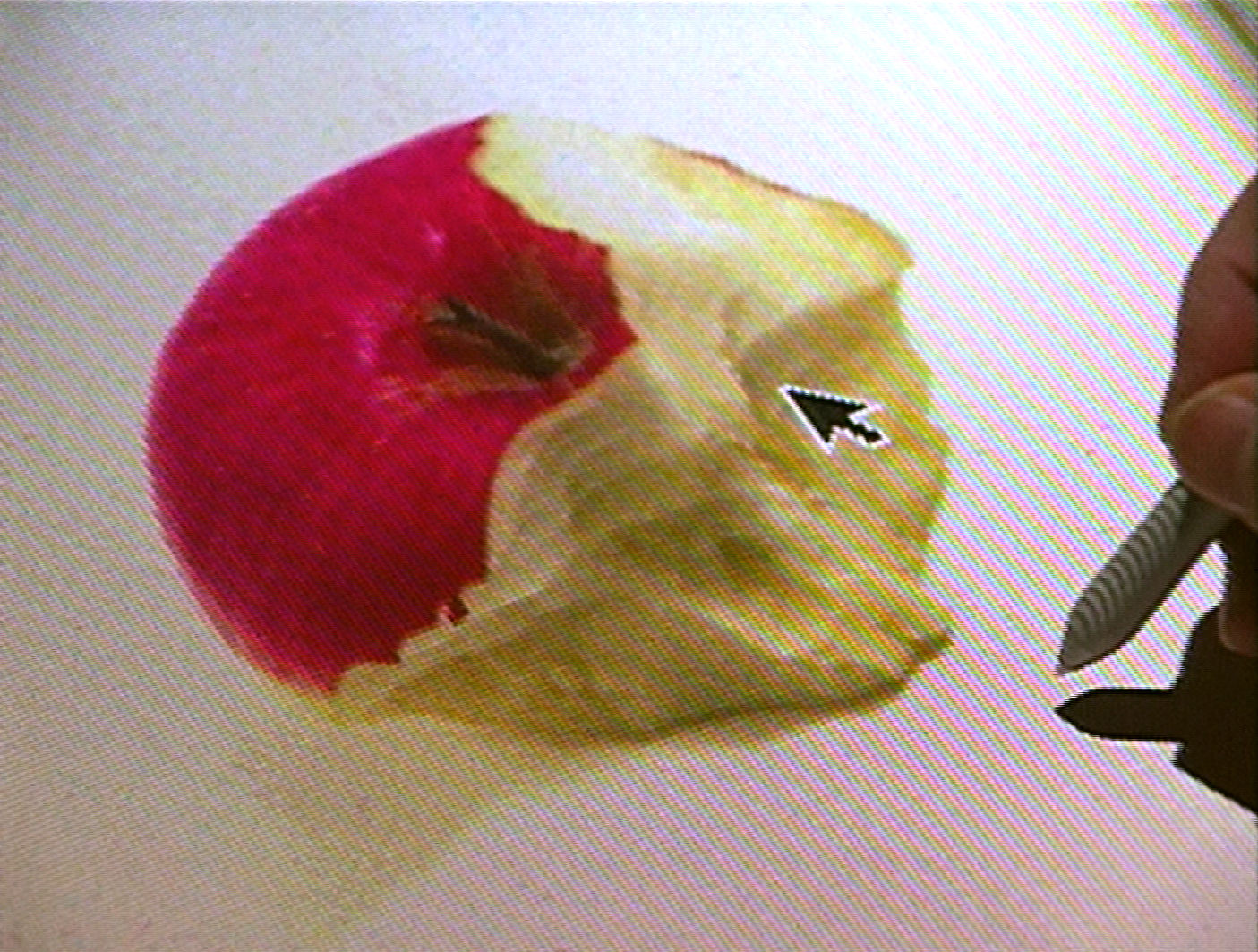
Beyond Pages aims to spark thoughts about both the true and future function of books where a book is not just an interface for storing and accessing information but also a portal that encourages additional forms of knowledge and creativity.
Interactivity
Its most simple explanation, ‘Interactive Art’ describes art that relies on the participation of spectators. However, with the rise of technology, Interactive Art and the term, “interactivity” is becoming increasing detachable from technology or rather cybernetics itself – “the science of communications and automatic control systems in both machines and living things”
A cybernetic spirit is understanding life at its simplest and most complex levels and having the ability to control it. In Beyond Pages, Masaki Fujihata believes that technology has the potential to shape valuable content through fantasy, concentration and curiosity. Through technology, opportunity for interactive art has increased as there are endless options to explore and allow for participation and communication of spectators.
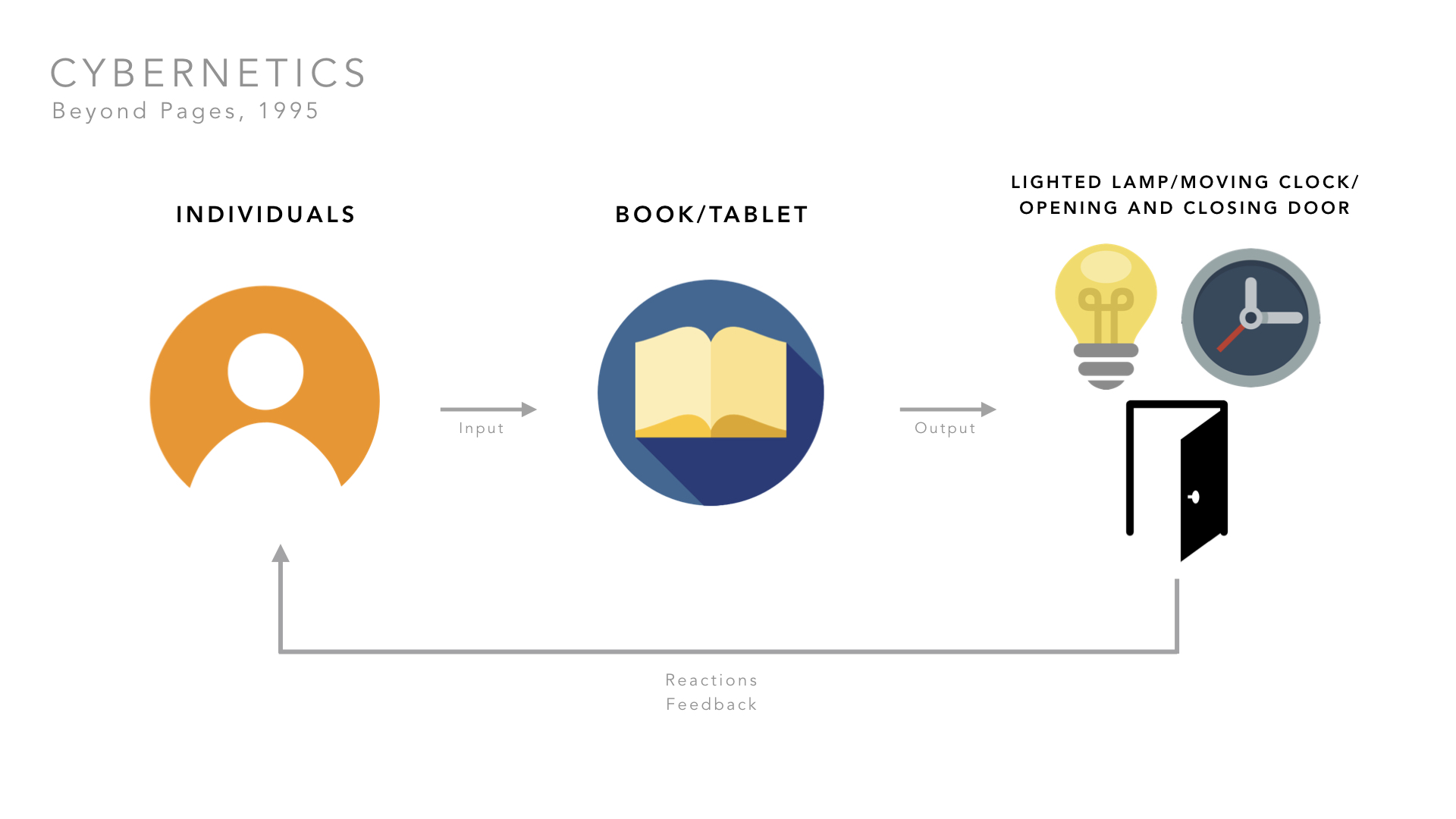
There are many ways to to interpret Masaki Fujihata’s exact sentiments about the installation. However interactive art then again, gives us the freedom to “create” our own experience and form our own interpretations. Through the fusion of technology and a traditional medium, Masaki Fujihata indeed, wanted to go beyond the pages, beyond the boundaries of a plain, simple medium – a book. Allowing spectators to experience moving images while “reading” a book and corresponding to their actions via a special pen, allows for communication and going beyond what we’re used to. I would like to share a remark from Jeffrey Shaw as he said, “Beyond Pages definitively and convincingly shows us that our information spaces are no longer bound within their traditional wrappers (book, stage, screen, canvas, etc.) – instead they can manifest themselves as ubiquitous presences that move between and link together the totality of things in a new imaginary of being.”
Thus, interactivity is not just the reliance of the participation of spectators, it is also what the spectators make out of the installation experience. It may make them ask questions, think, feel something or perhaps feel nothing at all.
Behavioural Art
Unique to every individual, Beyond Pages can create a fair variety of spectator experience depending on their choice of actions and reactions to the content. This links back to a quote from Roy Ascott’s reading, “Nowadays we are moving towards a situation in which the game is never won but remains perpetually in a state of play”
The words, “state of play”, suggest that one has the freedom to “play” however much he/she wants, thus, allowing each experience to be unique and different. In Beyond Pages, objects on the book do not respond until it is being touched or played around with in the right way. If the object does not detect the right motion to trigger the action, the object will remain static.
An example can be seen in this video where the person is unable to trigger the motion until after several attempts,
Some people may choose to make less attempts and not receive the full intended experience of the installation.
Immersion
Although Beyond Pages is not an installation involving Virtual Reality, spectators are still sat in a dark room meant to immerse them in a familiar room setting consisting of a table, chair, window, lamp and door. As seen from the video above, a light switch image on the “book” flicks on the light of the real lamp on the table. Such interactions allow people to be even more absorbed into the scene itself.
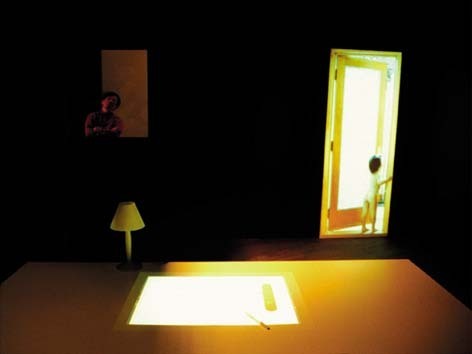
In order for a person to be fully immersed in a scene, human senses have to be involved. In the case of Beyond Pages, the sense of sight, sound and touch are fulfilled. This suggests that Beyond Pages sets a rather immersive environment for spectators but could be better “improved” with perhaps the sense of smell. Nonetheless, Masaki Fujihata may not have wanted the full immersive experience but perhaps wanted to lightly push spectators into it without completely forgetting about the function of a book.
Conclusion
Beyond Pages stretches the imagination and pushes the cognitive sphere of an individual. Besides just allowing for some form of interactivity, the cybernetic vision has followed through as there is a form of input, output and a feedback loop as shown in the diagram above. In addition to a never ending feedback loop, Masaki Fujihata managed to create an immersive environment for the installation, allowing individuals to feel as if they amongst the communication with virtual spaces.
Through the use of such simple and familiar daily objects, Masaki Fujihata has managed to add in an element of controlled entropy – not completely unpredictable in outcome but rather unpredictable in reaction. I wish to experience Beyond Pages for myself if ever possible.
References
https://homemcr.org/app/uploads/old_site/media/Art/Exhibition%20guides/Masaki%20Fujihata%201.pdf
http://pl02.donau-uni.ac.at/jspui/bitstream/10002/615/1/Roy%20Ascott.pdf
https://www.dictionary.com/browse/cybernetics
http://we-make-money-not-art.com/beyong_pages/
http://userwww.sfsu.edu/infoarts/links/actobjects/activatedartists.html
http://artelectronicmedia.com/artwork/beyond-pages
IMAGE references
http://www.laznia.pl/index.php?mod=aktualnosciart&aid=1077&&lang=en
http://build.isea-archives.org/person/masaki-fujihata/
VIDEO reference

